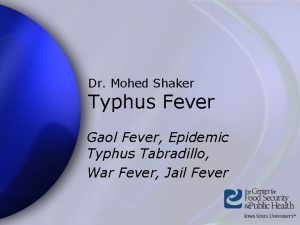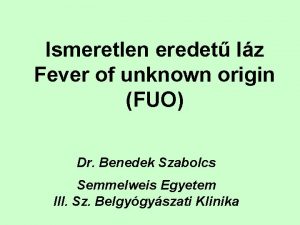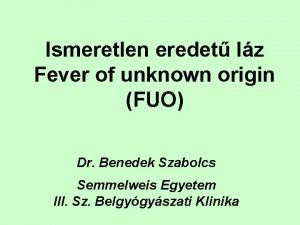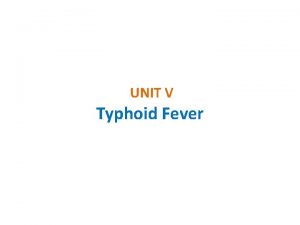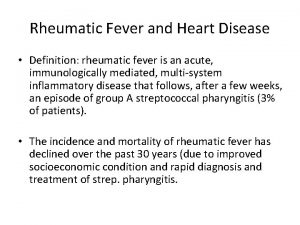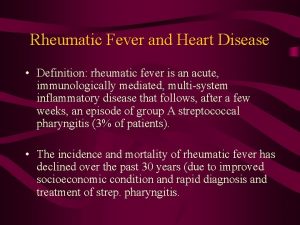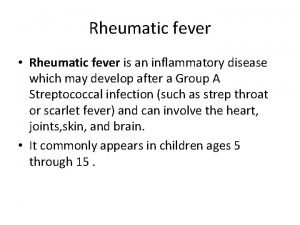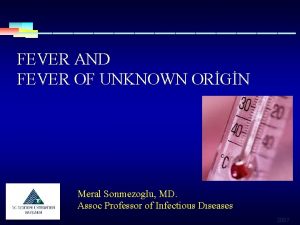FUO Definition Fever 38 c or higher for


























- Slides: 26




FUO Definition: Fever 38 ºc or higher for 20 days or more; in which l Careful history and clinical examination; l Urine and stools analysis; l Complete blood picture; l Widal agglutination test; l Chest X-ray; l Abdominal US; and l Routine therapy during the period of fever Do not clinch the diagnosis. l

Commoncausesof of. FUOin in. Egypt: 1 -1 -Infections(44 -50%). 2 -2 -Collagendiseases(20 -25%). Neoplasms(10 -15%). 3 -3 -Neoplasms Miscellaneousdiseases(8%). 4 -4 -Miscellaneous 5 - Undiagnosed (11%). In cases who received antibiotics or Incorticosteroids cases whothe received antibiotics or diagnosis may be masked. corticosteroids the diagnosis may be masked.

Infections They are the commonest cause of FUO in Egypt. a- Salmonella infection ( maltreated typhoid, chronic salmonellosis ). b- Extra-pulmonary TB. c- Urinary tract infections. d- Brucellosis. e- Bacteraemia and septicaemia. f- Infective endocarditis.

Infections g- Parasitic diseases : fascioliasis, amoebic liver abscess, trichinosis, toxocariasis, infected hydatid cyst. h- Viral diseases : CMV, EBV i- Localized infections : pyogenic liver abscess, psoas abscess, chronic prostatitis, subphrenic abscess and perinephric abscess. Diagnosis : Ultrasound and CT.

Infections A- Salmonella infection: l Maltreated typhoid : patient usually receives interrupted or incomplete underdosaged antibiotic therapy leading to slight amelioration of the general condition of the patient with persistance of fever. l Chronic salmonellosis : it is characterized by prolonged fever and bacteraemia in bilharizial patients.

Salmonella Infection l Chronic salmonellosis complicating: S. hematobium: remittent or intermittent type of fever of long duration and chills, dysuria and terminal hematuria. urine analysis: pus cells , increase bacterial count and S. hematobium ova. Repeated blood and urine cultures: S. paratyphi A more than S. typhi. IV pyelography: damaged urinary tract and evidence of obstructive uropathy.

Salmonella Infection Chronic salmonellosis complicating S. Mansoni infection: Continuous or remittent type of fever of long duration, chills, diarrhea, anorexia, epistaxis, loss of weight, abdominal pain. Patient is toxic, pale, there may be generalized lymphadenopathy, jaundice, edema of lower limb, petechial rash, purpuric eruptions, hepatosplenomegaly.

Salmonella Infection Diagnosis: Repeated blood cultures : salmonella typhi more than paratyphi. CBC may be normal or there may be anaemia and thrombocytopenia. Treatment: Eradication of salmonella from circulation by antityphoid drugs & prevent the occurance of relapses by anti-schistosomal drugs on 2 nd apyrexial day under antityphoid treatment.

B- Extra-pulmonary TB Affecting lymph nodes, liver, peritoneum and urogenital tract. -Clinical picture according to the part affected + FUO, weight loss, malnutrition, abdominal discomfort. -Anaemia, high ESR (over 100 ). -Highly +ve tuberculin test or variable response. -Normal chest X- ray. -Diagnosis: tissue biopsy and PCR, therapeutic test.

C- Urinary Tract Infections Intermittent fever, loin pain, dysuria, especially in females.

D- Brucellosis Backache, sweating without receiving antipyretics. l There may be low grade fever, malaise, weakness, fatigue, headache, myalgia. l There may be spleenomegaly, lymphadenopathy, hepatomegaly. Diagnosis: repeated blood cultures & serological tests. l

E- Bacteraemia & Septicaemia l Fever, chills, generalized aches, headache, sweating, abdominal pain. l The main signs are remittent fever, enlarged liver and or spleen. l The tetrade of seriously ill, feverish patient, anaemia, leucocytosis, high ESR is a good diagnostic aid for suspicion of septicaemia. Diagnosis: repeated blood culture during fever spike.

F- Infective Endocarditis Intermittent fever, organic heart disease and enlarged spleen. Diagnosis: - Repeated blood cultures. - Echocardiography : vegetations of the valves of the heart ( rapid, sensitive, non-invasive diagnostic technique especially in patients with – ve blood cultures).

Collagen Diseases Systemic lupus erythematosus ( SLE ). § Rheumatic fever. § Rheumatoid arthritis. §

Systemic Lupus Erythematosus Cases of SLE are characterized by affection of multiple unrelated systems : skin, joints, kidney, blood, serous membranes, nervous system. Ø Patient is usually female complaining of fever, arthralgia, falling of hair and cutaneous manifestations. ØFever may preceed the presence of seological markers by several months. ØFever + 2 or more of the following systems : skin, joints, kidneys, blood, serous membranes & nervous system.

Systemic Lupus Erythematosus Investigations: - High ESR. - C- reactive protein. - Anti-streptolysin O titre. - Antinuclear antibody & anti DNA. Antibody. - Rheumatoid factor.

Neoplasms Fever, weight loss, lymph node enlargement, splenomegaly, hepatomegaly. There may be severe anaemia, high ESR. e. g lymphoma, leukaemia, solid tumours.

Miscellaneous Familial mediterranean fever ( FMF ) : A A A A In children and adults. It is also called : periodic syndrome, armenian disease. 85 % of patients come from mediterranean region. Runs in families. More common in males. The disease is very chronic. Duration of illness 1 -25 years.

Familial Mediterranean Fever Pain fever pain ( Less than 3 days ) The whole duration of illness during the attack is not more than 4 days. Diagnosis : Clinically: fever of short duration, recurring at varying intervals over the course of many years. Pain is located in one or more of these sites : abdomen, chest, joints and skin.

Familial Mediterranean Fever Diagnosis is usually by exclusion. There may be moderate ESR, serum glucoproteins during the attacks. Provocative test: metarminol 10 mg infusion which is specific and highly sensitive. Treatment: colchicine 0. 5 mg twice per day during the attack.

Miscellaneous Drug fever: there may be fever, rash, arthralgia, eosinophilia. Factitious fever: frequent in soldiers and absentees, self induced fever as milk injections. Granulomatous diseases: TB, sarcoidosis, behcet’s disease and crohn’s disease.

Undiagnosed Fever These cases may resolve spontaneously or may recur at regular intervals. Therapeutic trials in cases of FUO : the drug used must be specific for the disease : - INH, Ethambutol in TB. - Salicylates in suspected rheumatic fever. - Flagyl in suspected amoebic liver disease. - Heparin in thrombophlebitis. - Withdrawal of drug in suspected drug fever

 Febbre fittizia
Febbre fittizia Gaol fever definition
Gaol fever definition Saddleback fever definition
Saddleback fever definition Kontinuitetshantering i praktiken
Kontinuitetshantering i praktiken Typiska drag för en novell
Typiska drag för en novell Tack för att ni lyssnade bild
Tack för att ni lyssnade bild Vad står k.r.å.k.a.n för
Vad står k.r.å.k.a.n för Varför kallas perioden 1918-1939 för mellankrigstiden
Varför kallas perioden 1918-1939 för mellankrigstiden En lathund för arbete med kontinuitetshantering
En lathund för arbete med kontinuitetshantering Personalliggare bygg undantag
Personalliggare bygg undantag Tidbok
Tidbok Anatomi organ reproduksi
Anatomi organ reproduksi Densitet vatten
Densitet vatten Datorkunskap för nybörjare
Datorkunskap för nybörjare Stig kerman
Stig kerman Hur skriver man en debattartikel
Hur skriver man en debattartikel Delegerande ledarskap
Delegerande ledarskap Nyckelkompetenser för livslångt lärande
Nyckelkompetenser för livslångt lärande Påbyggnader för flakfordon
Påbyggnader för flakfordon Formel för lufttryck
Formel för lufttryck Offentlig förvaltning
Offentlig förvaltning Jag har gått inunder stjärnor text
Jag har gått inunder stjärnor text Presentera för publik crossboss
Presentera för publik crossboss Teckenspråk minoritetsspråk argument
Teckenspråk minoritetsspråk argument Vem räknas som jude
Vem räknas som jude Klassificeringsstruktur för kommunala verksamheter
Klassificeringsstruktur för kommunala verksamheter Luftstrupen för medicinare
Luftstrupen för medicinare

